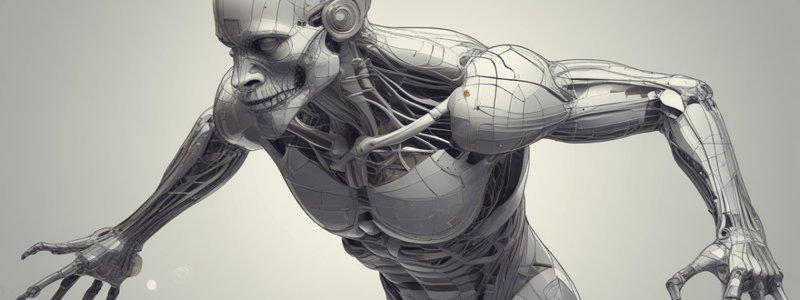Podcast
Questions and Answers
What is kinematics?
What is kinematics?
- A branch of mechanics that describes the motion that occurs between the articular surfaces of joints
- A branch of mechanics that describes the motion of bones relative to the three cardinal planes of the body
- A branch of mechanics that describes the motion of a body without regard to the forces or torques that may produce the motion (correct)
- A branch of mechanics that describes the forces that produce motion
What type of motion is described by osteokinematics?
What type of motion is described by osteokinematics?
- Motion that occurs between the proximal and distal segments of a joint
- Motion of bones relative to the three cardinal planes of the body (correct)
- Motion that occurs in a hinge joint
- Motion that occurs between the articular surfaces of joints
What is the difference between open and closed kinetic chain?
What is the difference between open and closed kinetic chain?
- Open chain: distal segment is fixed, proximal segment moves; Closed chain: proximal segment is fixed, distal segment moves
- Open chain: involves glide motion; Closed chain: involves roll motion
- Open chain: distal segment can rotate against a fixed proximal segment; Closed chain: proximal segment can rotate against a fixed distal segment (correct)
- Open chain: proximal segment is fixed, distal segment moves; Closed chain: distal segment is fixed, proximal segment moves
What type of joint motion involves rolling and gliding in the same direction?
What type of joint motion involves rolling and gliding in the same direction?
What determines the type of motion that occurs in a joint?
What determines the type of motion that occurs in a joint?
What is a characteristic of a hinge joint?
What is a characteristic of a hinge joint?
What is the movement axis in a sliding joint?
What is the movement axis in a sliding joint?
What type of joint motion involves a combination of rolling and gliding in opposite directions?
What type of joint motion involves a combination of rolling and gliding in opposite directions?
Which type of motion involves the proximal segment rotating against the relatively fixed distal segment?
Which type of motion involves the proximal segment rotating against the relatively fixed distal segment?
What is the primary factor that determines whether joint motion involves more sliding or more rolling?
What is the primary factor that determines whether joint motion involves more sliding or more rolling?
In which type of joint motion do the concave and convex surfaces move in opposite directions?
In which type of joint motion do the concave and convex surfaces move in opposite directions?
Which type of joint allows rotations around the longitudinal axis of the bone?
Which type of joint allows rotations around the longitudinal axis of the bone?
What is the relationship between the direction of osteokinematic motion and the direction of rolling and gliding in a joint?
What is the relationship between the direction of osteokinematic motion and the direction of rolling and gliding in a joint?
What is the characteristic of joint motion that occurs when the concave surface moves on a convex surface?
What is the characteristic of joint motion that occurs when the concave surface moves on a convex surface?
Which type of joint motion can be produced voluntarily in isolation?
Which type of joint motion can be produced voluntarily in isolation?
What is the plane of motion in which there is no movement axis?
What is the plane of motion in which there is no movement axis?
Flashcards are hidden until you start studying
Study Notes
Kinematic Principles of Joint Movement
- Kinematics: branch of mechanics that describes motion of a body without regard to forces or torques that produce the motion.
Osteokinematics
- Motion of bones relative to three cardinal planes of the body:
- Sagittal
- Frontal
- Horizontal
Arthrokinematics
- Describes motion that occurs between articular surfaces of joints:
- Roll
- Glide
- Spin
- Traction
- Compression
Kinetic Chain
- Open kinetic chain: distal segment can rotate against relatively fixed proximal segment.
- Closed kinetic chain: proximal segment can rotate against relatively fixed distal segment.
Joint Congruency
- Measures how well joint surfaces match/fit:
- More congruent: more sliding
- More incongruent: more rolling
Concave and Convex Rule
- Concave surface moves on convex surface (B):
- Rolling and gliding in same direction as osteokinematic
- Convex surface moves on concave surface (A):
- Rolling and gliding in opposite directions
- Rolling goes same direction as osteokinematic
Joint Types
- Plane joint:
- No movement axis
- Sliding movements in all directions
- Hinge joint:
- Allows rotations around transversal axis of joint
- Pivot joint:
- Allows rotations around longitudinal axis of bone
Studying That Suits You
Use AI to generate personalized quizzes and flashcards to suit your learning preferences.



